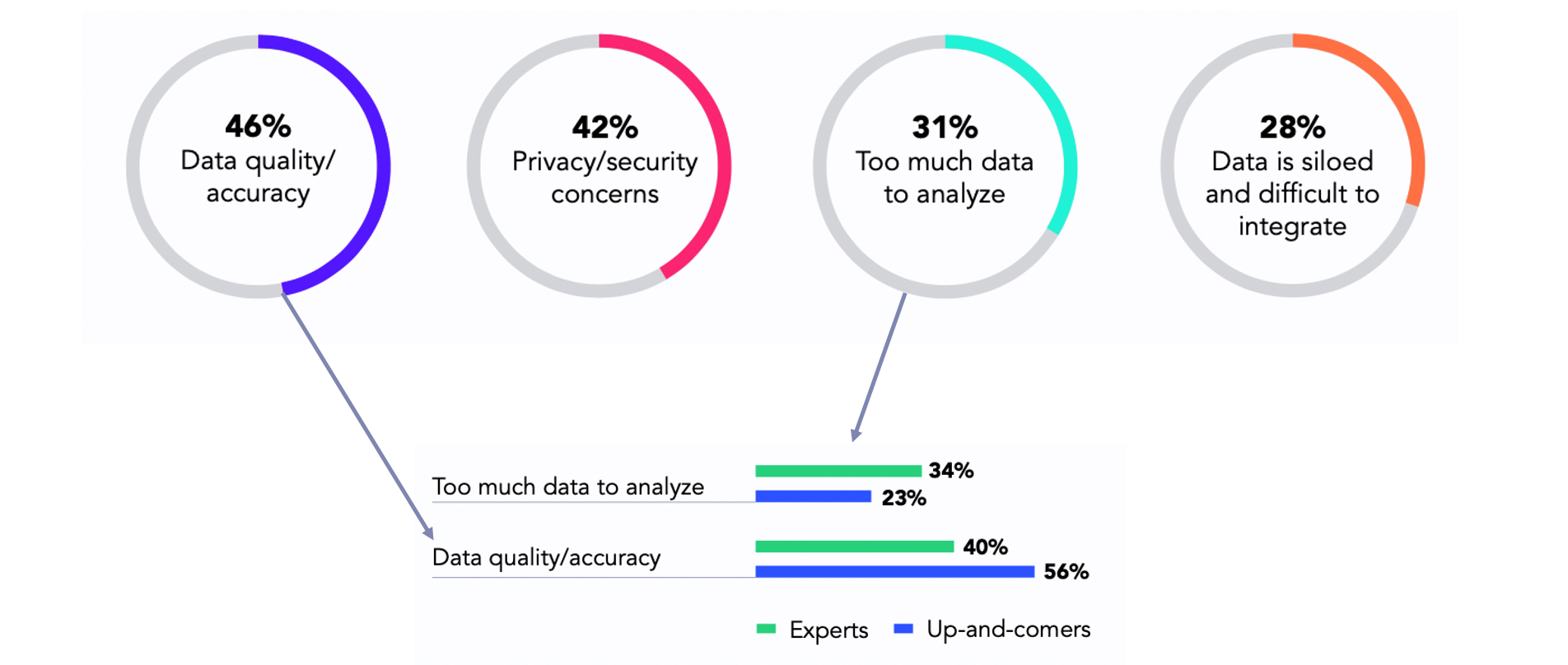Blog
Measure or Die – Why data-driven marketing is a must-have mindset in 2020
May 14, 2021 | Chris Kervinen

In 2020, World Federation of Advertisers conducted its largest global study to date , surveying 683 leading marketers from over 30 countries together with a global market research agency 2CV . The goal was to find out what are the biggest challenges today’s marketers face, what can be done to bridge any skill gaps that exist, and what else CMOs need to be conscious of to succeed into the 2020s. The massive research defined three core categories:

These categories represent more or less the biggest challenges CMOs around the world are facing today or have to face tomorrow. And regardless of industry, seniority or region, data-driven marketing provides a solution for them all.
Economic pressures – The need to do more with less
There aren’t probably many companies that didn't experience significant economic pressures mounting up during the latest white swan event (yes, it can’t be defined as a black swan event , as we did see this coming up – we just didn’t do anything about it).
But when considering the fact that the study’s interviews were already conducted before the pandemic, it’s obvious that the marketing proof gap – the difference between how CMOs and CEOs perceive the business impact that marketing generates – has been there for a while now. And when marketing is seen as “soft” function and the marketing budgets as costs instead of investments, well that’s when a form of marketing minimalism kicks in.

Marketing budgets around the world have been slashed, and the trend seems to continue. To get more resources, you’ll have to show that that money is invested to generate both short- and long-term growth
It's extremely difficult to achieve bigger impact with less resources, in marketing or in any other function. But it is possible. Probably the most important thing “doing more with less” -objective requires is resource reallocation. Successful resource reallocation in turn requires knowing how efficiently your current marketing mix is performing, and what’s the ”investment elasticity” for each channel.
The first tells you where you can and should start the surgery, whereas the latter helps you to avoid overinvesting in seemingly efficient media channels that have sharply decreasing ROMI (which seems to be the case with most of the marketing budget cutter companies that reallocate majority of the resources to online media channels – which are profitable with the current investment level, but stop being efficient when the budget is tripled).
“Successful resource reallocation in turn requires knowing how efficiently your current marketing mix is performing, and what’s the ”investment elasticity” for each channel”
Some might argue that data-driven marketing (utilizing statistical analysis and big data analytics to support the decision-making process) isn’t as useful or necessary as some of the industry experts claim. But it is practically impossible to measure individual media channel’s efficiency when there’s multiple overlapping offline and online media channels at play, not to mention interpreting the optimal investment levels and channel synergies.
You’ll have to analyze years of sales and marketing timeseries data, so having specifically designed algorithms for the “heavy lifting” definitely helps. Keep in mind that the granular, media channel-level metrics are not a nice-to-have, but must-have information if you want to become a marketing budget surgeon and truly to do more with less.
The more automated your data analysis processes are, the faster you’re also able to test and optimize stuff. It’s painfully naïve to assume you’ll get it right the first time, but then again the challenge isn’t about getting it right the first time, it’s about getting more accountable, transparent and predictable with the investments. There will be no more flashy marketing budgets in the future – unless you can prove that the campaign will deliver on commercial terms.
As The Economist put it : “If they [CMOs] can’t present what drives engagement in a compelling way to the CFO then they won’t pay attention.”
Technological demands – The need to stay up to speed
“The CMO role is under a major threat across the industry. And I keep calling it existential threat. Most of the CMOs have come from the creative side of the companies, out of the creative side of the function. And marketing is getting increasingly accountable for demonstrating the results in a credible, quantifiable fashion.
Marketing is becoming data driven. Marketing is being technology driven. And these are not default areas of the classical marketers, in most of the cases” – Raja Rajamannar, Chief Marketing & Communications Officer at Mastercard ( The Marketer of the Future research )
As Mr. Rajamannar’s comment points out, the role of a CMO has focused on creative and human aspects over the technical stuff. Yes, there’s an abundance of martech tools marketers can choose from, but only a few of them provide truly data-driven solutions in the end. Most of them are designed to tweak online marketing activities’ performance, so we could rephrase that Online Marketing is currently being technology driven.
The rest is still very human-centric, driven by gut feelings and legacy excels. It has been that way as long as we remember, so why fix what's not broken?

Technology and data dominates the digital marketing scene, but the same levers could be utilized with offline media channels as well
While it’s of course admirable to resist the Skynet , cloud-based data warehouses and AI-powered tools tend to provide substantial benefits once you join the dark side. And in the end, it’s not that you’ll automate the stuff that makes you that exceptionally great marketer you are – it’s the laborious, repetitive tasks that demand a huge portion of your time without providing any meaningful learning experience to anyone linked to the project.
It’s the tasks that we secretly hate but are afraid to give up because we’d look inefficient with so much free time. But trust me, your efficiency will skyrocket. However unbelievable that may sound to you.
“And in the end, it’s not that you’ll automate the stuff that makes you that exceptionally great marketer you are – it’s the laborious, repetitive tasks that demand a huge portion of your time without providing any meaningful learning experience to anyone linked to the project”
The efficiency uplift will come from doing the right things, instead of doing things right.
Because as the WFA and Economist’s studies both show, the role of the CMO is in a transformational stage. The role, and the marketing department’s function in general need to assume more collaborative and cross-functional capabilities in order to utilize the full potential of the brand and the products. Achieving this requires hard data to back up your decisions, but at the same time marketers can’t really afford to invest their time to crunch these numbers due to the new areas of responsibility.
And that’s why it’s absolutely necessary to
1) understand what areas of work technological solutions can support and
2) integrate these solutions into your day-to-day work.
It’s no use doing one without the other. And if you’re doing neither… well, there’s a great many stories in which technology has provided a crucial competitive advantage, but very few vice versa.
High consumer expectations – Brand purpose and changing consumer demand
The last 10 years have been amazing from the consumer perspective. You can basically get everything you want, whenever you want it and however you want it. From the marketer’s perspective this has created a complex entity of expectations, touch points and communication channels to manage (and ideally optimize).
And once again, while it’s not necessary to utilize data in finding the solution, doing so decreases your workload substantially.
While the idea of corporate algorithms knowing you better than you know yourself is luckily still only a dystopia, there’s a hint of truth in looking at the data to find out what kind of customer segments there might be.
A survey of 500 Business-to-Consumer marketers (published by Invoca in 10/2019) found out that the purchase history is the purchase history is the most highly valued and trusted first-party marketing data source– so it might be a good idea to use this data as the foundation to further research.

You can use data to build up assumption- and bias-free research hypotheses
The difference between data-driven and survey-based customer segmentation is that people can be biased with their poll answers but won’t lie (at least often) when voting with their wallet/feet. Another benefit of leveraging your purchase/transaction data is that you’re able to neglect your own assumptions (which can be quite persistent and prescriptive).
This doesn’t mean you can’t use all that expertise and silent knowledge in your head, you just have to use it to interpret the data, and not to manipulate it.
The challenge with assumptions is that ideal customer segments might be a lot different than what you have in mind. It’s not applicable anymore to use age, gender or region as core nominators for a segment. Instead, spot clusters in the data and figure out what these individuals have in common. What products are often bought together, how campaigns affect product-level sales, what’s the content in these campaigns and in which channels they’ve been promoted.
And then plan and execute the survey. You’ll get superior insights on what these target audiences think about your brand and how to affect them by implementing the research bottom-up, and not top-down.
“You’ll get superior insights on what these target audiences think about your brand and how to affect them by implementing the research bottom-up, and not top-down”
Keeping an eye on the sales data will also inform you when there’s changes in the consumer demand. These changes might be subtle or sudden, and it requires continuous reviews to spot them as early as possible. Surveys might suffice, but it is expensive to constantly carry out questionnaires, and the quality of the answers will likely start to decrease over time.
The sales data on the other hand is there 24/7, and the quality of the data should be diamond – assuming that the accounting team hasn’t dropped the ball. For example looking at how the sales developed during Covid-19 in the U.S . taught us something new about the “previously invisible” markets.
Branding has always been more than the numbers, but the two aren’t mutually exclusive. Although data can’t tell you why specific brand campaigns succeed, it can tell how much they contribute in the bottom-line growth. This is a result of rigorous analysis that measures and isolates the impacts of tactical marketing activities, price discounts, competitors’ actions and other external factors.
Excluding all the major drivers and looking at the Like-for-Like (that excludes store openings/closings) leaves you with an indicator of brand campaigns’ commercial impact. And like it or not, it depicts quite accurately how your customers have voted with their wallets.
Getting it right from the start
As we can see, marketers that won’t adopt technology- and data-driven processes will have huge disadvantage in solving the above mentioned challenges of the new decade. So, what hurdles marketers encounter when using data to optimize their processes?

Invoca: The State of First Party Marketing Data – Surveyof 500 Business-to-Consumer marketers in 10/19
When the data is scrambled across different systems and formats, it’s obviously very difficult, if not impossible, to extract any value from it. Algorithms are like a double-edged sword: They’re really powerful to generate insights from huge amounts of data, but the data has to be in a specific form for the model to understand it.
And for the same reason the need for marketers isn’t going anywhere with the technological innovations – it’s just developing from analyzing information (in which computers and AI outdo humans every time) to interpreting the results and connecting the dots. It’s the next step in the evolution of marketers.
Ready to embrace the future and take on the biggest marketing challenges in 2020?
Sources:
The Economist and Marketo’s research
Curious to learn more? Book a demo.
Related articles
Read more postsNo items found!